-
Countries
-
Data and Analysis
-
Special Focus
-
Crisis Responses
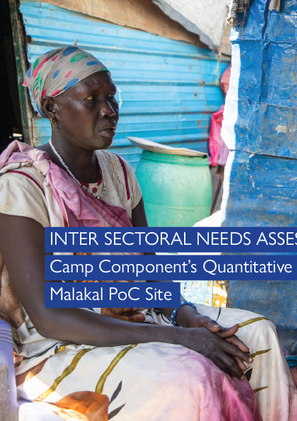
Contact
DTM South Sudan, SouthSudanDTM@iom.int
Language
English
Location
South Sudan
Period Covered
Sep 01 2022
Oct 31 2022
Activity
- Survey
- Return Intention
Between September and October 2022, the International Organization for Migration’s Displacement Tracking Matrix (IOM DTM) undertook its third household-level multi-sector assessment of selected urban areas and camps for internally displaced persons (IDPs) in South Sudan. The assessment aims to:
• Quantify the prevalence of vulnerabilities and humanitarian needs across sectors, with a focus on food security, economic vulnerability and nutrition as well as selected indicators on shelter and non-food items (SNFI), education, health, water, hygiene and sanitation (WASH), protection (including child protection and gender-based violence) and mental health and psycho-social support (MHPSS).
• Generate a better understanding of urban displacement and migration, including return and relocation after displacement in South Sudan or abroad.
There has been slow progress in the humanitarian situation in South Sudan. People’s humanitarian needs continue to rise, driven by cumulative and compounding effects of years of conflict, sub-national violence, food insecurity, climate crisis and public health challenges. Conflict and insecurity, fueled by sub-national and inter-communal violence, crime, and wide-scale impunity, continue to be among the main drivers of humanitarian needs in South Sudan.
Based on the request of the Humanitarian Country Team (HCT), mandated OCHA, IOM, and REACH to implement Inter-Sectoral Needs Assessment that aimed to understand demographics, multi-sectoral needs (including the level of severity) and barriers to assistance as well as displacement patterns and household-level scale.
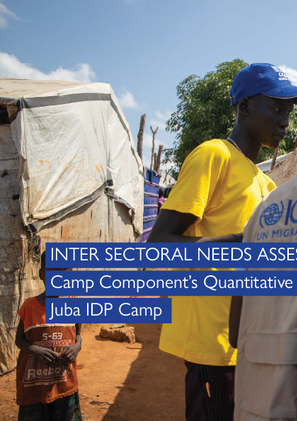
Contact
DTM South Sudan, SouthSudanDTM@iom.int
Language
English
Location
South Sudan
Period Covered
Sep 01 2022
Oct 31 2022
Activity
- Survey
- Return Intention
Between September and October 2022, the International Organization for Migration’s Displacement Tracking Matrix (IOM DTM) undertook its third household-level multi-sector assessment of selected urban areas and camps for internally displaced persons (IDPs) in South Sudan. The assessment aims to:
• Quantify the prevalence of vulnerabilities and humanitarian needs across sectors, with a focus on food security, economic vulnerability and nutrition as well as selected indicators on shelter and non-food items (SNFI), education, health, water, hygiene and sanitation (WASH), protection (including child protection and gender-based violence) and mental health and psycho-social support (MHPSS).
• Generate a better understanding of urban displacement and migration, including return and relocation after displacement in South Sudan or abroad.
There has been slow progress in the humanitarian situation in South Sudan. People’s humanitarian needs continue to rise, driven by cumulative and compounding effects of years of conflict, sub-national violence, food insecurity, climate crisis and public health challenges. Conflict and insecurity, fueled by sub-national and inter-communal violence, crime, and wide-scale impunity, continue to be among the main drivers of humanitarian needs in South Sudan.
Based on the request of the Humanitarian Country Team (HCT), mandated OCHA, IOM, and REACH to implement Inter-Sectoral Needs Assessment that aimed to understand demographics, multi-sectoral needs (including the level of severity) and barriers to assistance as well as displacement patterns and household-level scale.
Between September and October 2022, the International Organization for Migration’s Displacement Tracking Matrix (IOM DTM) undertook its third household-level multi-sector assessment of selected urban areas and camps for internally displaced persons (IDPs) in South Sudan. The assessment aims to:
• Quantify the prevalence of vulnerabilities and humanitarian needs across sectors, with a focus on food security, economic vulnerability and nutrition as well as selected indicators on shelter and non-food items (SNFI), education, health, water, hygiene and sanitation (WASH), protection (including child protection and gender-based violence) and mental health and psycho-social support (MHPSS).
• Generate a better understanding of urban displacement and migration, including return and relocation after displacement in South Sudan or abroad.
There has been slow progress in the humanitarian situation in South Sudan. People’s humanitarian needs continue to rise, driven by cumulative and compounding effects of years of conflict, sub-national violence, food insecurity, climate crisis and public health challenges. Conflict and insecurity, fueled by sub-national and inter-communal violence, crime, and wide-scale impunity, continue to be among the main drivers of humanitarian needs in South Sudan.
Based on the request of the Humanitarian Country Team (HCT), mandated OCHA, IOM, and REACH to implement Inter-Sectoral Needs Assessment that aimed to understand demographics, multi-sectoral needs (including the level of severity) and barriers to assistance as well as displacement patterns and household-level scale.
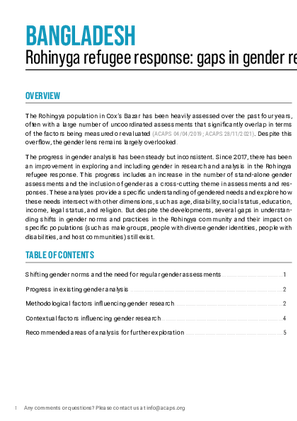
Contact
NPM Bangladesh, NPMBangladesh@iom,int
Language
English
Location
Bangladesh
Period Covered
Jan 01 2018
Dec 31 2022
Activity
- Other
The Rohingya population in Cox’s Bazar has been heavily assessed over the past four years, often with a large number of uncoordinated assessments that significantly overlap in terms of the factors being measured or evaluated (ACAPS 04/04/2019; ACAPS 28/11/2021). Despite this overflow, the gender lens remains largely overlooked.
The progress in gender analysis has been steady but inconsistent. Since 2017, there has been an improvement in exploring and including gender in research and analysis in the Rohingya refugee response. This progress includes an increase in the number of stand-alone gender assessments and the inclusion of gender as a cross-cutting theme in assessments and responses. These analyses provide a specific understanding of gendered needs and explore how these needs intersect with other dimensions, such as age, disability, social status, education, income, legal status, and religion. But despite the developments, several gaps in understanding shifts in gender norms and practices in the Rohingya community and their impact on specific populations (such as male groups, people with diverse gender identities, people with disabilities, and host communities) still exist.
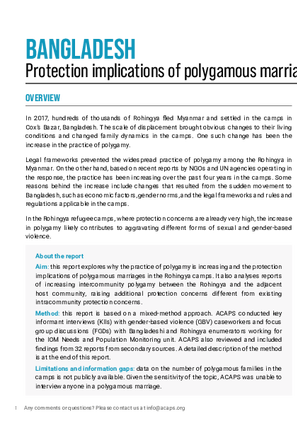
Contact
NPM Bangladesh, NPMBangladesh@iom,int
Language
English
Location
Bangladesh
Period Covered
Jan 01 2018
Dec 31 2022
Activity
- Other
- Survey
- Community Perception
In 2017, hundreds of thousands of Rohingya fled Myanmar and settled in the camps in Cox’s Bazar, Bangladesh. The scale of displacement brought obvious changes to their living conditions and changed family dynamics in the camps. One such change has been the increase in the practice of polygamy.
Legal frameworks prevented the widespread practice of polygamy among the Rohingya in Myanmar. On the other hand, based on recent reports by NGOs and UN agencies operating in the response, the practice has been increasing over the past four years in the camps. Some reasons behind the increase include changes that resulted from the sudden movement to Bangladesh, such as economic factors, gender norms, and the legal frameworks and rules and regulations applicable in the camps.
In the Rohingya refugee camps, where protection concerns are already very high, the increase in polygamy likely contributes to aggravating different forms of sexual and gender-based violence.

Contact
NPM Bangladesh, NPMBangladesh@iom,int
Language
English
Location
Bangladesh
Period Covered
Jan 01 2018
Dec 31 2022
Activity
- Other
In late 2021, ACAPS’ Cox’s Bazar Analysis Hub embarked on research to understand the development of humanitarian needs in the Rohingya refugee crisis. The research was mainly based on the comparison of findings from four consecutive years (2018–2021) of Multi Sector Needs Assessments (MSNAs). The report titled Needs and Priorities of Rohingya and Host Communities in Cox’s Bazar since 2017 was published on 30 August 2022.
The 2019 Rohingya MSNA aimed to “provide an analysis of how refugees’ population and host communities’ needs have changed in 2019”, while the 2020 and 2021 Rohingya MSNAs aimed “to facilitate an understanding of the evolution of needs and service gaps across time” (ISCG 05/2019, 06/05/2021, and 08/08/2022). Despite the similarity, direct comparisons of the yearly situations still proved challenging.
This technical note outlines the key challenges the ACAPS team faced while analysing and comparing data across multiple MSNAs. To develop an understanding of the Rohingya crisis over time, the team included other sources of information, such as the WFP Rohingya Influx Emergency Vulnerability Assessments (REVAs), especially for food and livelihood needs, and information supplied specifically from the sectors. On that note, similar comparability issues were also observed with these other assessments and information sources.
This note aims to highlight how assessment design, data collection, and results presentation enable (or prevent) trends analysis. It also aims to encourage assessment designers and coordinators to consider the future use of their data with the immediate requirements, even as they seek to improve data collection or overcome changes based on the context of the people in need.

Contact
NPM Bangladesh, NPMBangladesh@iom,int
Language
English
Location
Bangladesh
Period Covered
Jan 01 2018
Dec 31 2022
Activity
- Other
August 2017 and the months that followed saw the influx of more than 700,000 Rohingya refugees fleeing violence in Myanmar’s Rakhine state to Cox’s Bazar, Bangladesh. This influx brought the Rohingya refugee population in Cox’s Bazar to over 900,000 (IOM 31/03/2022). While there has been continuous humanitarian support for the refugees, restrictions imposed in response to COVID-19 interrupted some humanitarian activities and forced the scaling down of others. Humanitarian activities had fully resumed by mid-2021, but the negative impacts of COVID-19 restrictions persist (ISCG 04/11/2021).
Since 2017, the refugees’ prioritisation of their needs has changed. In the first months after arriving in Cox’s Bazar, the focus was almost entirely on basic needs, such as food, water, shelter, and safety and security. As the situation stabilised, income-generating activities and education became increasingly important. The effect of COVID-19 and increased government restrictions that reduced livelihood opportunities and access to education reinforced the prioritisation of these needs for the Rohingya. For people living in host communities, there is a similar trend regarding priority needs.
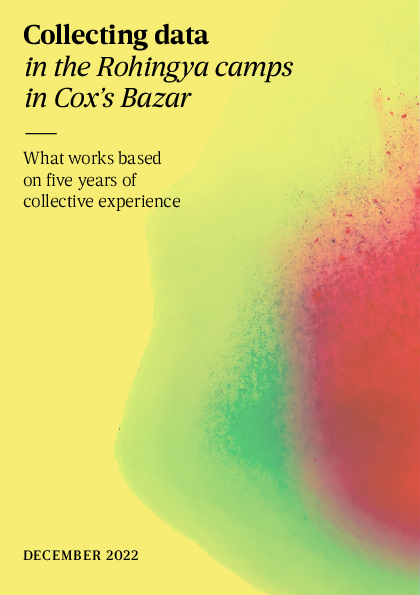
Contact
NPM Bangladesh, npmbangladesh@iom.int
Language
English
Location
Bangladesh
Period Covered
Jan 01 2018
Dec 31 2022
Activity
- Other
Data collection in humanitarian response is based on established standards, guidelines, and good practices that have evolved over time. While these practices give a general structure for data collection processes, they need to be adaptable to any specific response context. This learning document highlights the lessons learnt from five years of data collection in the Rohingya camps in the form of assessments, monitoring, and evaluation activities whether rapid or comprehensive, sectoral or multisectoral, joint or standalone, and other types of studies. This document aims to help adapt data collection processes to the Rohingya response in Cox’s Bazar based on collated experiences and learning. The methods used to collect data include surveys, group discussions (GDs) including focus group discussions, interviews including key informant interviews (KIIs), and direct observations. The terms ‘data collectors’ and ‘participants’ or ‘respondents’ are used for the main stakeholders involved in data collection exercises.

Contact
NPM Bangladesh, npmbangladesh@iom.int
Language
English
Location
Bangladesh
Period Covered
May 01 2022
Apr 30 2023
Activity
- Survey
- Community Perception
During an emergency and time of displacement, the psychosocial implications of displaced people are affected and the breakdown of the usual protective institutions such as the family, community, government, law enforcement structures, etc. increase the intensity of different protection issues. Since people have a lack of awareness about their rights and entitlements in an unfamiliar environment, the risk of exploitation and abuse increase. Although Sexual Exploitation and Abuse by humanitarian workers (“SEA”) can occur in any humanitarian or development context, it is a specific risk in emergency contexts as it brings a rapid increase in the number of partners for the humanitarian response, rapid recruitments and staff turnover, high work pressures, and challenges to ensuring effective coordination and oversight, thus expanding the risks of all forms of misconduct, including SEA.
It has been six years since Rohingya refugees fled from Myanmar to Bangladesh and the humanitarian response remains focused on meeting humanitarian needs. A PSEA network was established in 2017 to prevent SEA risks and respond to allegations reported. IOM-NPM in coordination with the PSEA Network conducted an assessment to understand the perception of Rohingya refugees on existing complaints and feedback mechanisms (CFMs) in the camps, especially focusing on reporting sensitive issues, namely Sexual Exploitation and Abuse (SEA). Until now, the NPM and the PSEA Network conducted 3 surveys. The first survey2 was conducted from December 2021 to January 2022 in 4 Camps, the second survey3 was conducted from August 2022 to September 2022 in 6 camps, and most recently, the third one, has been conducted in May-June 2023 in 7 camps.
Contact
DTM Yemen, iomyemendtm@iom.int
Location
Yemen
Activity
- Mobility Tracking
- Event Tracking
Period Covered
Jul 01 2023 -Sep 30 2023
From 1 January to 30 September 2023, IOM Yemen DTM tracked 4,600 households (HH) (27,600 Individuals) who experienced displacement at least once..
Between 1 July and 30 September 2023, IOM Yemen DTM tracked 1,089 households (6,534 individuals) displaced at least once. The majority of people moved into/within the following governorates and districts:
- Ma’rib (494 HHs) – Ma’rib City (207 HHs), Ma’rib (150 HHs), Harib (136 HHs) districts. Most displacements in the governorate originated from Ma’rib and Al Hodeidah.
- Ta’iz (282 HHs) – Mawza (70 HHs), Jabal Habashi (67 HHs), Al Makha (29 HHs) districts. Most displacements in the governorate originated from Ta’iz and Al Hodeidah..
- Al Hodeidah (218 HHs) – Hays (155 HHs), Al Khukhah (57 HHs), At Tuhayta (6 HHs) districts. Most displacements in the governorate originated from Al Hodeidah and Ta’iz..
- Ta’iz (359 HHs) – Maqbanah (156 HHs), Al Makha (38 HHs), Mawza (31 HHs) districts..
- Al Hodeidah (258 HHs) – Hays (75 HHs), At Tuhayta (30 HHs), Al Jarrahi (29 HHs) districts..
- Ma’rib (199 HHs) – Harib (154 HHs), Al Jubah (19 HHs), Majzar (9 HHs) districts..
Population Groups
Survey Methodology
Unit of Analysis Or Observation
Type of Survey or Assessment
Keywords
Geographical Scope
Administrative boundaries with available data
The current dataset covers the following administrative boundaries
